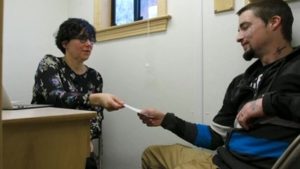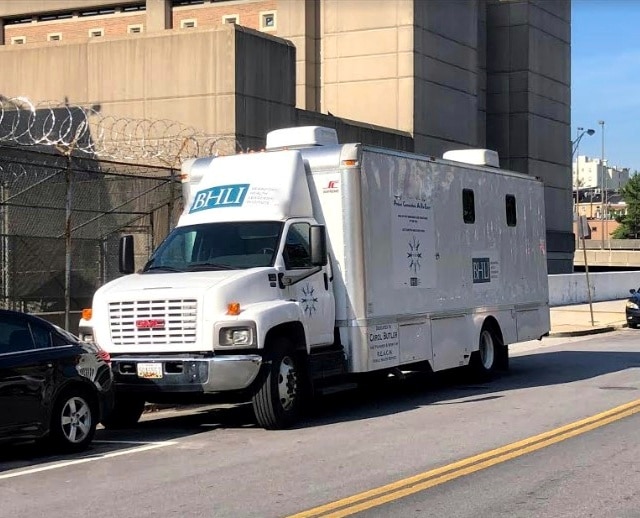In 2017 the Behavioral Health Leadership Institute (BHLI), a Baltimore nonprofit, rented a truck. The large white GMC van sits outside of the Baltimore Central Booking and Intake Center Jail on 300 E Eager Street, four days a week.
The program, called Project Connections at Re-Entry (PCARE), takes a harm reduction approach—including prescribing buprenorphine. BHLI has been providing low-threshold addiction support in community centers for over 15 years. But two years ago the organization expanded its work to the doors of a jail. People are most vulnerable to overdose immediately after release, BHLI Director Deborah Agus told Filter.
An estimated two-thirds of people who are arrested in Maryland have drug-related problems. People who use opioids lose their tolerance if they’re forced into abstinence while incarcerated—as is typical. In 2018, the Centers for Disease Control noted evidence that 10 percent of people who die of overdose had been released from an institutional setting the prior month.
In its two years of operation, PCARE has served hundreds of people in its truck. Most are justice-involved and/or experiencing homelessness. According to BHLI data, 85 percent of patients are African-American men. The mean age is 44, with a mean of 24 years of opioid usage; 94 percent had previous criminal justice involvement, 73 percent were unemployed, and 71 percent were unstably housed. Over a third of patients had previously overdosed.
“There are heartbreaking and heartwarming stories everyday,” Agus said of working with this population. She recounted the stories of one man whose brother died in his arms from an overdose. Of an amateur baseball player, who was beaten so badly by the police that he had to quit. Of a veteran who had been using street opioids for 20 years—and after five months of treatment at PCARE, was about to transfer over to a primary care physician to receive longer-term care.
Critically, the program does not require identification, insurance or abstinence from any drugs; nor does it require its patients to attend group meetings. As well as buprenorphine, patients are given naloxone kits and fentanyl-testing strips. PCARE’s doctors will connect patients who remain engaged—and who wish to transition—to a primary care clinic for continued buprenorphine prescribing and other medical help, or to a more comprehensive outpatient substance use program.
 PCARE operates in a flexible “pop-up” style, which allows it to meet people’s needs individually and adapt to changing circumstances. It has no security staff, as this could be off-putting to people hesitant to approach the truck.
PCARE operates in a flexible “pop-up” style, which allows it to meet people’s needs individually and adapt to changing circumstances. It has no security staff, as this could be off-putting to people hesitant to approach the truck.
Agus was very purposeful in staffing the van. “Everyone who works there is extremely experienced and therefore generally more comfortable with risk. It is a totally judgement-free space,” she said, noting that this welcoming and experienced staff is one of the reasons for the program’s success.
“The beauty of this work is because there is no barrier between you and the patient.”
One of those staff members is Dr. Megan Buresh, a primary care and addiction physician at the Johns Hopkins Hospital. Buresh believes PCARE’s model of treatment has yet to expand because funding is difficult to come by—and because traditional healthcare systems are reluctant to use a harm reduction approach.
“There are preconceived notions about what it looks like to engage with justice-involved people,” Buresh told Filter. “The beauty of this work and why I love it so much, though, is because there is no barrier between you and the patient.”
Buresh is passionate about working for equal access. Only 10 percent of those needing treatment are able to get it, she said. Insurance, program requirements and identification are major barriers—ones that PCARE eliminates.
“We are patient-centered. We encourage, rather than penalize, and find other ways to measure improvement,” said Buresh. “Access must really mean access.”
 While Buresh and her fellow PCARE doctors are subject to the federal X-Waiver, which limits doctors’ buprenorphine patient numbers, the scale of PCARE’s current operations and the involvement of several prescribers means that this has not so far been a limiting factor.
While Buresh and her fellow PCARE doctors are subject to the federal X-Waiver, which limits doctors’ buprenorphine patient numbers, the scale of PCARE’s current operations and the involvement of several prescribers means that this has not so far been a limiting factor.
“Ultimately, for me, this work is hopeful,” said Buresh. “I see people transition from shame and the margins to being able to re-engage with families and celebrate their successes.”
Lizzie Spradley, now nurse manager of PCARE, has also been working there since the truck’s initiation. She told Filter that she appreciates the difference in approach from her previous inpatient work at Johns Hopkins Hospital.
“We are able to adapt to changes and people’s needs in a way that we can’t do in a more bureaucratic place,” she said. “We’re doing a real disservice when we make people buy into a system where they may not be respected or heard. With our truck, you can stay with us and we meet you where you are.”
BHLI is in the process of expanding PCARE’s programming to a full five days a week. The truck is currently open four half-days a week, and can accommodate 12 patients per half-day—which, according to Deborah Agus, is not enough.
“We are always having to turn people away,” she said. Buresh added that this is one of the hardest parts of her job.
“People inside jails should have the option for treatment. However, jail is not where we want to be treating people.”
In 2018, there were 1,578 opioid-involved deaths in the Baltimore metropolitan area, with 814 in the city itself. Increased awareness and concern has resulted in a shift towards providing treatment in jail and prisons. But Agus does not believe a true harm reduction model can be employed within a jail, so has opted to remain outside of those walls.
“People inside jails should have the option for treatment, and have a constitutional right to treatment,” she said. “However, ultimately, jail is not where we want to be treating people and should be reserved only for people who belong there. No one should be incarcerated solely because, as a result of their substance use disorder, they use illicit drugs. It is wrong to criminalize a disease. Patients with substance use disorder need treatment that meets their needs and includes access to primary care.”
PCARE has been well received by its community, according to BHLI, and plans for its expansion are certainly welcome.
Agus is realistic in recognizing the limits of a truck’s capacity to bridge the treatment gap. But this low-threshold, on-the-spot option does make a difference to a number of people who have been violated or traumatized by the system.
Correction, September 25: This piece has been edited to give the most accurate available figures for opioid-involved deaths in Baltimore in 2018.
All photographs courtesy of the Behavioral Health Leadership Institute.





Show Comments